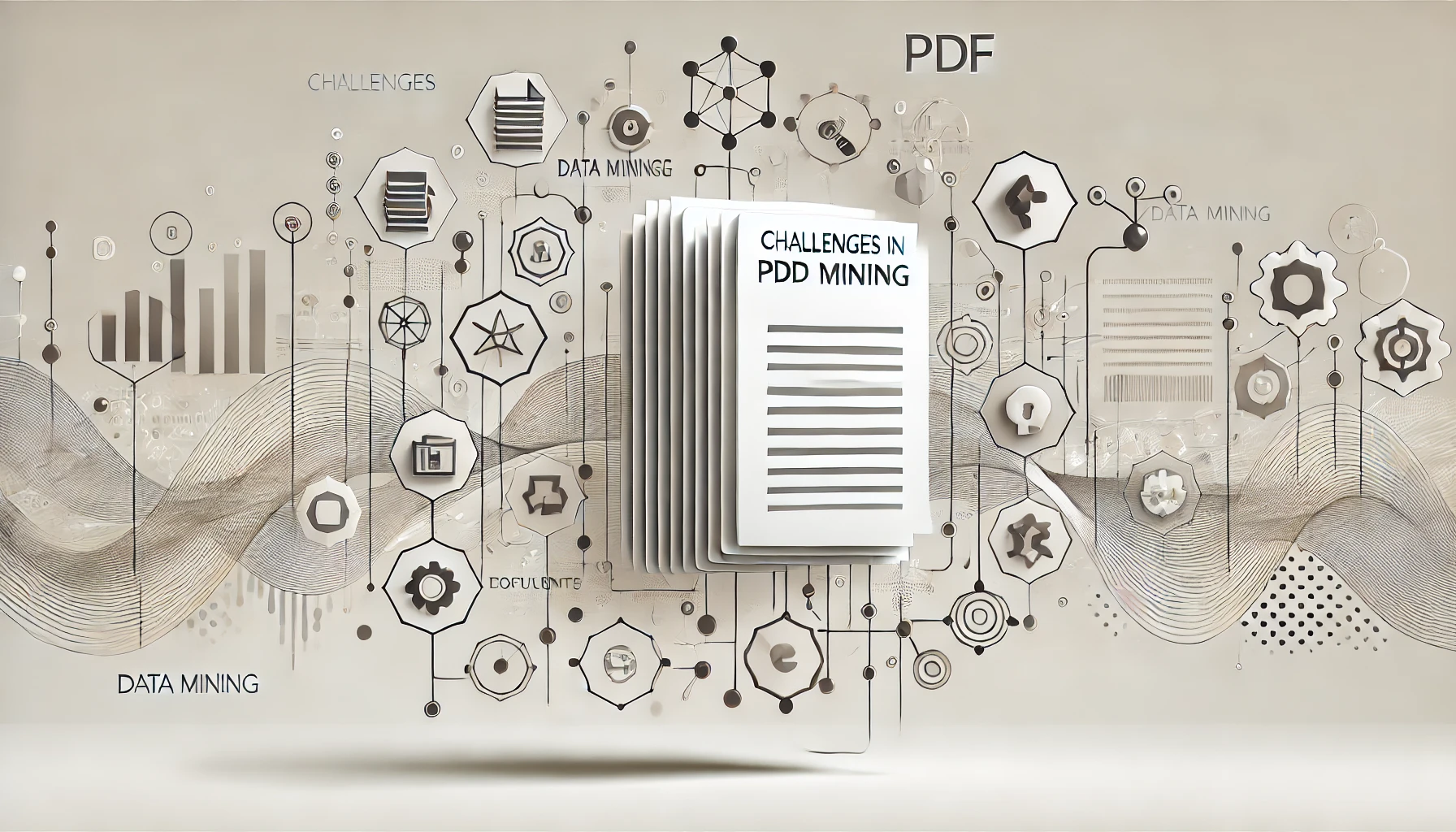When it comes to PDF data mining, did you know that efficiency gains of up to 50% can be achieved by implementing the right strategies? With 8 genius ways to enhance your data extraction process, you’ll discover a world where automation tools, machine learning techniques, and advanced processing methods converge to revolutionize your mining operations. Stay tuned to unravel the secrets behind optimizing your workflow and unlocking the full potential to improve efficiency in PDF Data Mining.
Automation Tools
To enhance the efficiency of PDF data mining, employing automation tools is essential. Automation tools streamline the process by enabling a user-friendly interface that simplifies the extraction of valuable information from vast amounts of data. These tools offer features such as real-time updates, which ensure that the latest data is always being analyzed. By utilizing automation tools with a user-friendly interface, you can easily navigate through the data mining process, saving time and increasing productivity.
The user-friendly interface of automation tools allows for a seamless experience, where even those without extensive technical knowledge can effectively utilize them. This simplicity enhances the overall workflow and reduces the learning curve associated with complex data mining tasks. Additionally, the real-time updates provided by these tools ensure that you are working with the most current data available, leading to more accurate insights and decision-making.
Machine Learning Techniques
Employing machine learning techniques is a strategic approach to further enhance the efficiency of PDF data mining. When delving into machine learning for PDF data mining, consider the following:
- Feature Selection: Optimal feature selection is vital to enhance the performance of machine learning models. By selecting the most relevant features from the PDF documents, you can improve the accuracy and speed of the mining process.
- Model Evaluation: Thorough evaluation of machine learning models is crucial for determining their effectiveness in extracting valuable information from PDFs. Utilize metrics like precision, recall, and F1 score to assess the performance of the models accurately.
- Hyperparameter Tuning: Fine-tuning the hyperparameters of machine learning algorithms can significantly impact the efficiency of PDF data mining. Experiment with different parameter configurations to find the best settings for your specific mining task.
Preprocessing Steps
A critical aspect of optimizing PDF data mining processes is the implementation of preprocessing steps. Before diving into data extraction, it is essential to perform data validation to ensure accuracy and reliability. By validating the data, you can identify and rectify any inconsistencies, errors, or missing information present in the PDF documents. This step is crucial for maintaining the integrity of the extracted data and improving the overall quality of the mining process.
Additionally, utilizing Optical Character Recognition (OCR) software is key in preprocessing PDF files. OCR software converts scanned PDF documents into machine-readable text, making it easier to extract and analyze data. By employing OCR technology, you can enhance the efficiency and accuracy of the data mining process, especially when dealing with large volumes of PDF files containing textual information.
Choice of Extraction Method
When considering the choice of extraction method in PDF data mining, one key aspect to focus on is extraction accuracy importance. Evaluating whether to employ automated or manual extraction methods is crucial in determining the efficiency of the data mining process. Additionally, integrating specialized tools for extraction can offer significant benefits in terms of speed and accuracy.
Extraction Accuracy Importance
To ensure optimal efficiency in PDF data mining, the choice of extraction method holds significant importance, particularly in relation to extraction accuracy. When considering extraction accuracy, factors such as data validation and accuracy assessment play a crucial role in determining the effectiveness of the chosen method.
Here are three key points to consider regarding the importance of extraction accuracy in PDF data mining:
- Data Integrity: The accuracy of the extraction method directly impacts the integrity of the extracted data. Inaccurate extraction may lead to errors in the analysis, affecting decision-making processes based on the mined information.
- Quality of Insights: The precision of the extraction method influences the quality of insights derived from the data. Higher extraction accuracy enhances the reliability of the conclusions drawn from the mined information.
- Resource Optimization: Optimal extraction accuracy minimizes the need for manual intervention to correct errors, saving time and resources in the data mining process. Efficient extraction methods contribute to overall productivity and effectiveness in data analysis.
Automated Vs Manual
In the realm of PDF data mining, an essential decision lies in determining whether to employ automated or manual extraction methods. When it comes to time savings, automated extraction methods outshine manual ones. Automation significantly reduces the time required for extracting data from PDF documents, allowing for quicker analysis and decision-making processes.
Moreover, error reduction is another critical factor to consider. Automated extraction methods minimize the risk of human error, ensuring higher accuracy and consistency in the extracted data. Manual extraction, on the other hand, is more prone to errors due to human factors such as fatigue, distractions, and oversight.
Tool Integration Benefits
Moving forward from the comparison between automated and manual extraction methods, the focus now shifts towards the advantages that tool integration brings when deciding on an extraction method. When considering the benefits of tool integration for PDF data mining, there are several key points to keep in mind:
- Integration Challenges: Tool integration streamlines the data extraction process by allowing different software tools to work together seamlessly. This minimizes compatibility issues and reduces the time spent on manual data transfers between systems, enhancing overall efficiency.
- Customization Options: Integrating various tools provides the flexibility to customize extraction methods to suit specific project requirements. This level of customization enables users to tailor the data mining process to extract information in a way that best meets their needs.
- Enhanced Accuracy and Consistency: By integrating tools, you can ensure a higher level of accuracy and consistency in data extraction. Automated workflows reduce the risk of human error and ensure that the extracted data is more reliable for analysis and decision-making.
Handling Different Data Types
When handling different data types in PDF data mining, it is crucial to ensure data type compatibility to prevent errors in analysis. Utilizing data transformation techniques can help in converting disparate data types into a unified format for streamlined processing. Understanding how to effectively handle various data types is essential for accurate extraction and interpretation of information from PDF documents.
Data Type Compatibility
How can PDF data mining processes effectively handle different data types to ensure compatibility and enhance overall efficiency? When dealing with varied data types, employing data normalization strategies and typecasting solutions becomes crucial for seamless operations.
To ensure data type compatibility, consider the following:
- Data Normalization Strategies: Implement techniques like standardizing data formats and units across all sources. Normalizing data ensures that disparate types can be effectively compared and analyzed without discrepancies.
- Typecasting Solutions: Utilize typecasting methods to convert data from one type to another when necessary. This ensures that different data types can be processed uniformly, facilitating streamlined analysis and extraction of valuable insights.
- Data Type Validation: Implement robust data type validation checks to identify and handle any inconsistencies in the data. By verifying the types of data being processed, you can prevent errors and ensure accurate results in your PDF data mining endeavors.
Data Transformation Techniques
Implementing effective data transformation techniques is essential for handling different data types efficiently in PDF data mining processes. Data validation plays a crucial role in ensuring the accuracy and reliability of the extracted information. By validating the data during the transformation process, you can identify and correct any inconsistencies or errors, improving the quality of the final results.
Text analysis is another key aspect of data transformation when dealing with various data types in PDFs. Through text analysis, you can extract valuable insights from unstructured data, such as identifying patterns, trends, and relationships within the text. This technique allows you to convert textual information into structured data, making it easier to analyze and interpret the content.
Multithreaded Processing
To enhance the efficiency of PDF data mining processes, incorporating multithreaded processing can significantly accelerate data extraction and analysis. Utilizing parallel computing and task distribution, multithreaded processing allows for the simultaneous execution of multiple threads within a single process, enabling faster data parsing and extraction. Here are three key benefits of implementing multithreaded processing in PDF data mining:
- Improved Speed: Multithreaded processing leverages parallel computing to divide tasks into smaller subtasks that can be executed concurrently. This results in faster data extraction and analysis compared to traditional sequential processing methods.
- Enhanced Resource Utilization: By efficiently distributing tasks across multiple threads, multithreaded processing optimizes resource utilization, allowing for better utilization of available processing power and memory.
- Scalability: Multithreaded processing offers scalability by enabling the system to handle larger volumes of PDF documents without compromising performance. As the number of threads increases, the system can adapt to process more data effectively.
Use of Cloud Computing
Cloud computing offers a dynamic and scalable solution for optimizing PDF data mining processes. By leveraging cloud services, you can achieve significant cost savings compared to traditional on-premises infrastructure. The pay-as-you-go model of cloud computing allows you to scale resources up or down based on your needs, providing flexibility and cost-efficiency.
One of the key advantages of using cloud computing for PDF data mining is the scalability options it offers. You can easily adjust computational resources to handle varying workloads, ensuring optimal performance during peak times without over-provisioning during off-peak periods. This scalability helps in managing costs effectively by paying only for the resources consumed.
Moreover, cloud computing eliminates the need for upfront investments in hardware and software, reducing capital expenses. It also streamlines maintenance and updates, freeing up your team to focus on data mining tasks rather than IT infrastructure management. Overall, incorporating cloud computing into your PDF data mining workflow can enhance efficiency, reduce costs, and improve scalability options.
Dealing With Data Quality Issues
Addressing data quality issues is paramount in optimizing PDF data mining processes. When dealing with PDF data, ensuring accuracy and reliability is crucial for meaningful insights. Here are three key strategies to effectively manage data quality:
- Data Validation: Implement robust data validation processes to check for completeness, accuracy, and consistency within the PDF files. This step helps in identifying any anomalies or discrepancies in the data that could impact the mining process.
- Error Correction: Develop systematic error correction mechanisms to rectify any inaccuracies or inconsistencies found during the data validation process. By promptly addressing errors, you can enhance the overall quality and reliability of the mined data.
- Continuous Monitoring: Establish a framework for continuous monitoring of data quality throughout the mining process. Regularly reviewing and updating validation and correction protocols ensures that the data remains accurate and up-to-date, leading to more reliable insights and analysis. By prioritizing data quality management, you can optimize the efficiency and effectiveness of your PDF data mining endeavors.
Frequently Asked Questions
How Can I Ensure Data Privacy and Security During PDF Data Mining?
To ensure data privacy and security during PDF data mining, you must implement data encryption, access controls, and secure algorithms. Compliance monitoring is crucial for maintaining confidentiality. Protect sensitive information effectively with these measures.
Can PDF Data Mining Be Used for Real-Time Data Extraction?
Yes, PDF data mining can be used for real-time data extraction. Implementing real-time monitoring tools allows for instant extraction of data, enabling quick analysis. This approach enhances efficiency and facilitates timely decision-making processes in various industries.
What Are the Limitations of PDF Data Mining in Terms of Scalability?
When it comes to PDF data mining, scalability challenges can arise due to the format’s complexity and structure. Performance issues may occur as the volume of data increases, impacting the efficiency of extraction processes.
How Can I Effectively Handle PDFS With Complex Layouts and Structures?
To effectively handle PDFs with complex layouts and structures, you should employ advanced layout analysis techniques. Utilize tools for structured data extraction to accurately interpret the content. This approach ensures precise data retrieval from intricate PDF documents.
Is There a Way to Track Changes and Updates in the Extracted Data From PDFS?
You can ensure data integrity tracking and version control in extracted PDF data by implementing automated systems that monitor changes. This approach helps you maintain accuracy and trace modifications efficiently throughout the process.



